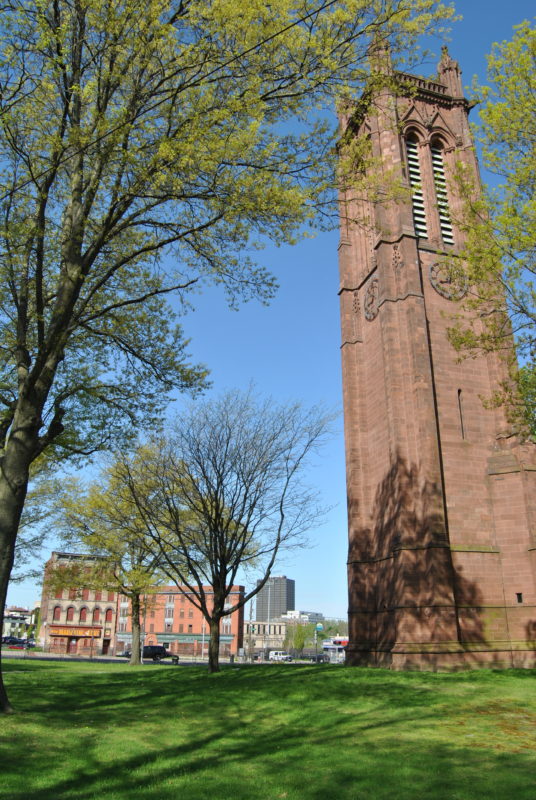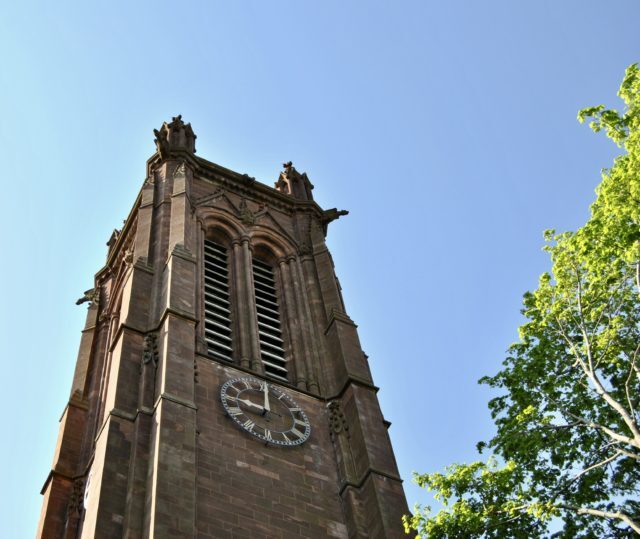Keney Tower is located in the center of a square — a park owned by the City of Hartford. Its boundary clearly marked by a fence. In 1980, the Courant described the area in less than flattering terms: “Keney Tower, just south of Albany Avenue, is in an area where drunks walk past buildings with boarded windows.” And though it had been there for some time, another newspaper article from the 1990s made it a point to describe a tire store as neighboring the park.
Today, the tower green is mowed. There is no litter to be seen in the park. There was also nobody sitting on the park’s many benches on a beautiful spring day.
The clock tower began chiming in 1899, then had a period of silence. Electronic bells were used in the 1990s. Then, silence. In 2019, the original chimes were restored.

Before all this, Henry and Walter Keney operated a wholesale grocery store at Main and Ely Streets in 1830, and at least according to an 1895 article in the Hartford Courant, it was “the oldest grocery house.” Their father started the business, and when he passed, an uncle kept it going until the Keney brothers took it over. Later, William Tucker and Henry Goodwin joined the business. Following the death of Henry Keney and another associate, Ebenezer Roberts, the grocery became Tucker & Goodwin, and operated from 8 Hurlburt Street.
A bronze plaque indicates that the Keney Memorial Clock Tower is a way of honoring Henry and Walter Keney’s mother, but as it turns out, that’s nothing more than a cute story.
The tower was intended as a tribute to the family’s grocery business.
From Henry Keney’s will:
“I give and devise to Ebenezer Roberts, Rev. Francis Goodwin, John H. White, and Henry H. Goodwin, in trust, all my land and the buildings thereon, situated on the corner of Main and Ely streets, formerly the homestead of my father, and where my brother, the late Walter Keney, and myself were born, and where for many years the firm of H. and W. Keney have been engaged in mercantile business; the same to be held by my said trustees for the following uses and purposes, viz.: The present firm, now doing business in the store, may continue there for so long a time as Mr. Ebenezer Roberts may elect, and upon such terms as may be agreed upon between said firm and my said trustees. Whenever the premises shall be vacated by said firm and come into the possession of my said trustees, said trustees shall proceed to remove the buildings thereon and appropriate and expend so much money from my estate as, in their judgement, will be sufficient to erect on said land some suitable and proper memorial, according to their taste and judgement, to perpetuate the memory of the firm of H. and W. Keney; and when the same is fully completed, to transfer and convey the same, and the land upon which it stands, to the City of Hartford or to Wadsworth Atheneum, as my said trustees may elect.”¹
That tire store? For several decades since 1935, Firestone had been on the former site of the Keney brothers’ mansion, which had been razed in 1933. In 2005, there was a mixed use development proposed for the site; this included a supermarket. There was also a failed attempt to develop it into a McDonald’s, around 2006. This spot (31, 580 square feet) has been vacant for years.
The site behind the tower? Several homes lined Winthrop Street between Ely and Pleasant Streets. This included the home of Joseph H. Sprague, one of Hartford’s mayors. It was also the YWHA’s first site, in 1920, before moving to Ann Street. The YWHA was a precursor to the Hartford Jewish Community Center (JCC), which is now on Bloomfield Avenue in West Hartford. Other buildings, described by the newspaper as tenements, had been reportedly removed by 1964. In the late 1970s there was an attempt to use some of the land along Winthrop Street as a place for a senior center. That was shot down by the Barnard Brown School as well as some of those using the senior center, and it was not clear why that site was ever floated out as a place to park the portable trailer. The Albany Avenue Senior Center, at the same time, was seeking to have the Keney Memorial Tower and its park designated as a “grandparents’ parkette.” This site (65, 340 square feet) on Winthrop Street, like the corner of Ely and Main Streets, has been vacant for years.
What about Tunnel Park (1441 Main), the overgrown and neglected piece of land where Main and Albany come together? It seems that nobody has ever quite gotten it together to make this an inviting space, and it’s almost as if nobody has wanted to.
A newspaper article from 1887 explained that part of the park was designated for building, and hinted that there had been confusion over who — the railroad or the City — owned what.
For years, Tunnel Park neighbors protested the existence of benches on site because they attracted “hoboes,” in the parlance of the day — a population that City employees did not hesitate to refer to as “undesirable” in the papers. The City even argued that adding benches would be a way to drive out this element, the logic being that the more places for “decent people” (in the words of the Superintendent of Parks), the less comfortable it would be for the homeless. What was so objectionable? Empty whiskey bottles and men singing in the middle of the night. Residents in the area petitioned in 1926 to remove the park for the purpose of widening the roadways. The following year when seventeen empty bottles were found in the park, there were again calls from a neighbor to remove all the benches from Tunnel Park. Not fine the litterbugs or install trash barrels, but remove all the benches to discourage park use. After all, the paper called the park a “constant source of annoyance.”
In 1923 permission was granted for installation of a trolley waiting station and a comfort station (restrooms) in the park. Nothing was noted of a waiting station after 1923. Requests for a comfort station on site were renewed in 1939. A member of the City Council, in 1950, sounded defeated over the matter of wanting to install comfort stations in the park. He made repeat attempts at this, and was denied. The City Manager claimed that giving people a dignified place to relieve themselves would create a “difficult police problem.”
Still, an Honor Roll was erected there in 1943.
Then, a library branch was proposed for Tunnel Park in the 1930s. That never materialized. The conditions of the land’s lease stated that only a comfort station or trolley waiting station could be built on the park. Today, the area acts as a bus stop, but it lacks what one might expect to find at such a facility.
In 2004, there were calls to add “landscaping, lights, and welcome signs” to improve the space. It looks like an overgrown parking lot, with its shabby fencing.
Tunnel Park (19,950 square feet) is now owned by NES Group Investments, based in Brookline, Massachusetts. It is getting no use, as is, and could be an ideal spot for local youth to play if someone were to show responsibility by maintaining the space.
Cities are always in flux, their character ever-changing. In a place so layered with history, it is important to remember that almost always a site has had a different previous use than what we have known it to have for the last generation or so.
- Henry Keney’s will — signed December 23, 1893 — can be found at the Connecticut Historical Society in its research center

Mickey
Thanks for great article! Heres hoping the trend for more green space continues.
Greg Andrews
Great work, Kerri. We now have a well- researched look at the vicissitudes of two related and urban parks. Hope we can now do better.